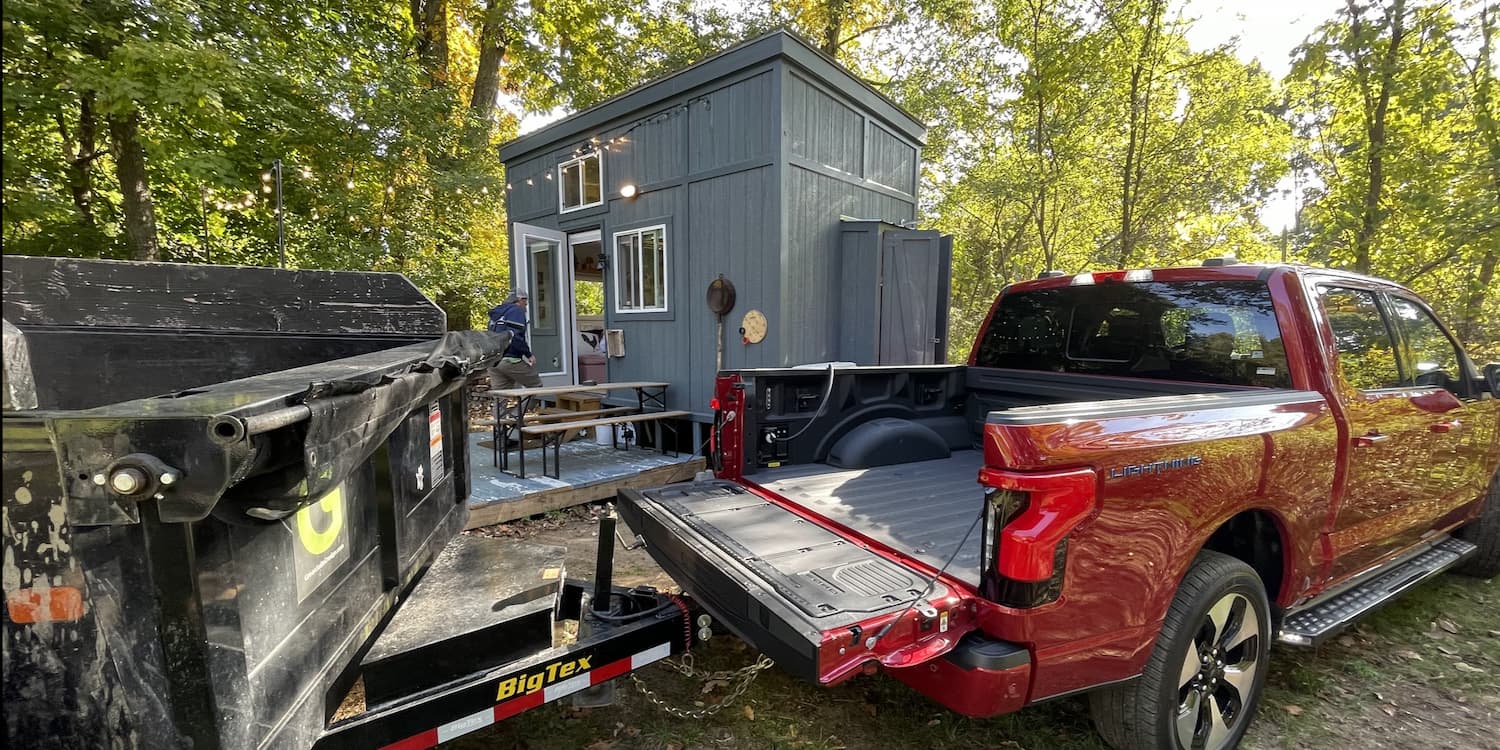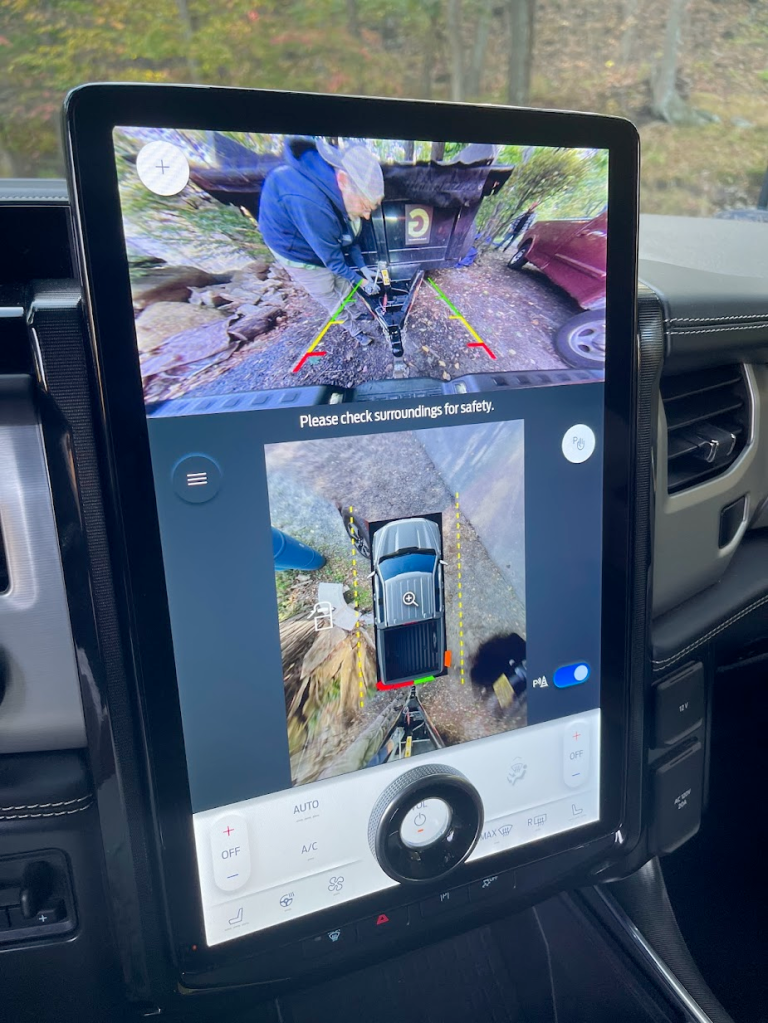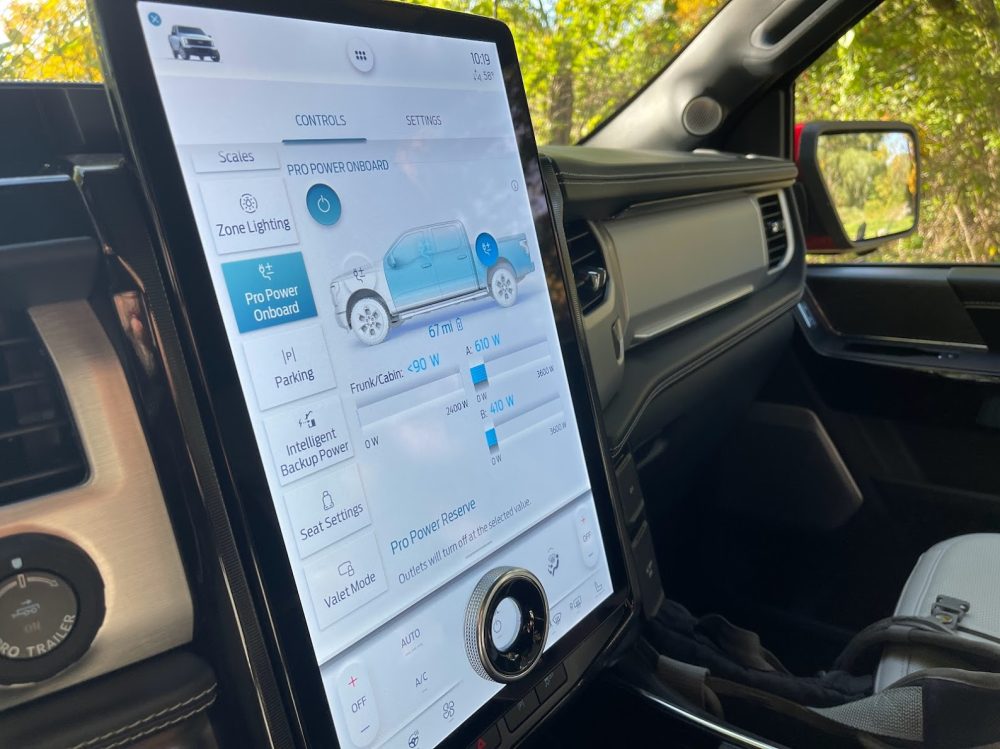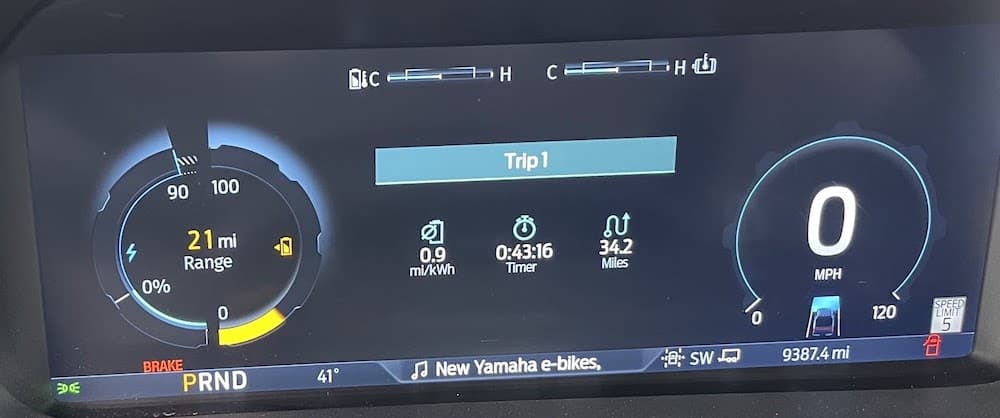
Ford has been taking some hits in the media on the F-150 Lightning towing range, so we thought it would be good to test it ourselves and then get the background from the people who built the Lightning, especially as we head into winter. Along with Ford’s PR team, we were joined by:
- Dapo Adewusi, F-150 Lightning Engineering Manager
- Gitanjli McRoy, Chief Engineer, EV Energy Management Systems
Here’s the discussion along with firsthand towing impressions below in both New York and Detroit.
I wanted to see how much range I’d lose while towing because there have been some recent videos showing only low double-digit-mile ranges coming out of the Lightning.
It is hard to quantify how much range you’d lose because of a ton of significant factors, like trailer weight, aerodynamics, and efficiency as well as normal EV range factors like elevation, climate, speed, etc., which are magnified while towing a trailer.
So I did two different tows: one with an open hauling trailer with a friend in New York and one with a closed trailer in Detroit – both very different experiences.
F-150 Lightning towing in the New York hills
After receiving the F-150 Lightning loaner, I immediately went to a friend’s place to try some towing. He’s got a tiny house Airbnb north of New York City, which requires hauling loads of firewood into the mountains. As the weather gets colder, the tiny house mini split heating requires 240V power, and we wanted to see if the Lightning could power it.
His trailer is about 7×5 feet and weighs about 5,000 pounds loaded. Using the rear and above camera views makes hitching the trailer a breeze.

Without any outside instruction, we were able to enter the info into the Lightning’s towing configurator and were off in a matter of minutes.
The trip was mostly uphill, and after about six minutes, our already dropping fast range dropped by about half, which was initially very scary. I had started the trip with about 180 miles of range and within a few miles of uphill road, we were at about 140 miles of range. The truck recalibrated us down to 68 miles of range, which was a bit scary since we had planned to try powering the house while we were there and had to make it back as well.
The truck continued to lose range quicker than we were using it until the top of the mountain where it equalized with the range. That gave us a lot of confidence to try powering the house since most of the return trip was downhill and we would be without the load of wood.
Lightning powers a tiny house, including heating, easily
This exercise doesn’t really have to do with towing, but while we were at the Tiny House, we decided to try to power the whole house, including mini split heating, using the F-150 Lightning’s Pro Power on board and 240V generator plug.
It just works. Usually, this requires a generator or a very large solar/battery setup, but not only can you tow a Tiny House (or Airstream/camper) to the middle of nowhere, you can also power it and heat it with the F-150 Lightning. I think I may have sold a few F-150s on this alone.
With the heat on full blast, the two power outputs stabilized at just over a kW, meaning we could have powered this thing for a full day using about 25kWh of battery.

The interesting thing about the trip back is that we ended with just about the same range as we’d started with, so we must’ve regenerated close to the 10 miles of range of the trip going downhill.
F-150 Lightning towing on flat ground
In Detroit, we drove an 8,000-pound trailer, 8×8 feet front end, about 15 miles on the highway, with about five miles of city driving, then 15 miles to return. Initially, while on the highway, I kept it at about 55-60mph (just under 100kmph). Most of the Detroit area is quite flat, so elevation isn’t a factor here, and it was about 40 degrees with rain. During this time, I saw energy usage at 1 mile/kWh, which means we can extrapolate 130+ miles from the 131kWh usable battery. I would use this figure as a baseline for towing. You might get better in warmer, dryer conditions with a smaller trailer, but starting here is easy and effective, and you can always drop down to this speed when towing on the highway.
While driving in the city with stops and starts, I saw the mi/kWh go down to .9, so keep in mind that city driving with an 8,000-pound load won’t necessarily save you range.
On the return trip, I tried hitting 65-70mph for brief periods, and that took the power usage down to .8 miles per kWh. So by driving just 10 mph faster, the range went from approximately 130 miles to about 100 miles.
Conclusion: Speed kills range, but it kills it even harder with a 64-square-foot front trailer. I imagine the videos where the F-150 Lightning gets only a low double-digit range are staged or at best poorly planned.
I finished with the following numbers after mixed driving:

F-150 Lightning Towing Observations
- Probably the biggest takeaway for me is that towing is highly dependent on outside variables, many of which are controllable by the driver. Just dropping from about 67mph to about 57mph, for instance, added around 30 miles of towing range. The off-roading trim on my F-150 Lightning drops about 50 miles from the nontowing range, so prioritize accordingly.
- Preconditioning the vehicle in cold weather can save almost all losses from the weather. Towing does put a higher strain on the batteries, but that heat keeps the pack warm and helps heat the interior of the vehicle.
- One interesting thing I noted in hilly New York was that you lose a lot going uphill, but the regen going back down often mostly makes up for it (something that isn’t the case for ICE trucks).
- On highway driving, as long as the trailer is built and maintained well, weight IS NOT a huge factor in flat road driving but aerodynamics IS. It makes sense since once you get the inertia going, weight doesn’t really put a force on the vehicle (as long as the speed is consistent), but the drag from the trailer is a constant and strong force, which increases exponentially with speed.
- Plows (would impede the frunk) and camper backs aren’t currently supported officially on the F-150 Lightning, but Ford is taking this into consideration for the future. Ford also notes that it is your truck, and you can do what you want with it. Also, Ford officially supports putting 400 pounds in the trunk, which is a lot less than most plows.
- The overall towing experience is so smooth and effortless compared to ICE that drivers might forget they are towing. There’s no audible cue of higher revving and struggling motors. The electric drive system makes slowing down and speeding up seem like a normal drive. Ironically, forgetting you have a trailer can actually be a concern when maneuvering/cornering, so stay alert!
- There’s no way to sugarcoat it: The Lightning’s towing range isn’t as robust as its ICE counterparts. If you are towing a tiny house up a remote mountain, you might want to look elsewhere. However, for over 90% of towing use cases, the Lightning suffices, especially if planned accordingly. The growing density of charging stops makes it easier every day.
FTC: We use income earning auto affiliate links. More.





Comments